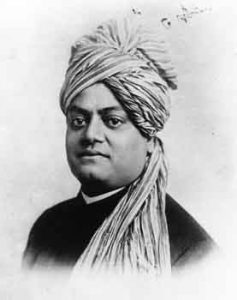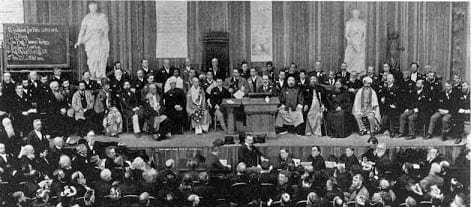Swami Vivekananda’s parivrajaka life traveling through India is reasonably well documented. His travel around the United States has also been well captured. Recently Asim Chaudhari has written eloquently about these in his book ‘New Discoveries’. I would like recount the visit of Swamiji to China.
Swamiji was on his first visit to the United States. He was going there to attend the World Parliament of Religions. He set sail from Bombay on the 31st of May 1893. He was to reach the United States through Colombo, Penang, Singapore, Hong Kong and Japan. The ship had arrived from Singapore and reached Hong Kong. Here it halted for three days. It was during these three days that Swamiji traveled to Canton, 80 miles up the Si-Kiang river. China, the Chinese people and their way of life always fascinated Swamiji. In a humorous vein, the Swami wrote in a letter dated July 10th, “The Chinese child is quite a philosopher and calmly goes to work at an age when your Indian boy can hardly crawl on all fours. He has learnt the philosophy of necessity too well. Their extreme poverty is one of the causes why the Chinese and the Indians have remained in a state of mummified civilization. To an ordinary Hindu or Chinese, everyday necessity is too hideous to allow him to think of anything else.”
The three days at Canton was a great learning experience for Swamiji. He understood how high caste Chinese women would never be seen in public and how the feet of the laboring women would not be larger than that of a child. He visited several Buddhist temples and tried to compare and contrast the Buddhist carvings on the temples in India and China. Being a Sannyasi, one of his earnest desires was to visit a Chinese Monastery and interact with the monks there. Unfortunately, these monasteries were forbidden to foreigners. He requested his interpreter to take him to a monastery but he politely refused fearing for his life. He informed Swamiji that he would surely be ill-treated and beaten up if he tried to force his way into a monastery. Swamiji was not to be easily discouraged. He insisted and convinced his interpreter to accompany him to a nearby monastery. As they approached it, two-three men appeared menacingly with their clubs. Before his interpreter ran away to a safe distance, Swamiji learnt from him the Chinese word for monk. As the men approached him, he called out loud that he was an Indian yogi. That word seemed to act like magic. The angry expression of the men changed to reverence and they fell at his feet. They spoke to him in a loud voice and one word that Swamiji understood of this was ‘Kabatch’. Unsure of what it meant, he turned to the interpreter who was standing at a safe distance. The interpreter explained that they were asking him for ‘amulets’ to ward off evil spirits and unholy influences. Though the Swami was taken aback for a moment and did not believe in charms and amulets, he knew that he had to do something and satisfy these new friends. He quickly took a sheet of paper from his pocket, tore it into small pieces and wrote the word ‘Om’ in Sanskrit on each of them. He gave them the pieces of paper, and the men, touching them to their heads, led him into the monastery. In the monastery, he was shown around and to his surprise he found many Sanskrit manuscripts and some written in old Bengali characters. This led him to infer that possibly there were many interactions between China and Bengal and there must have been an influx of Buddhist monks from both sides.
From Hong Kong, Swamiji continued his journey and his next stop was Nagasaki in Japan.






Leave A Comment